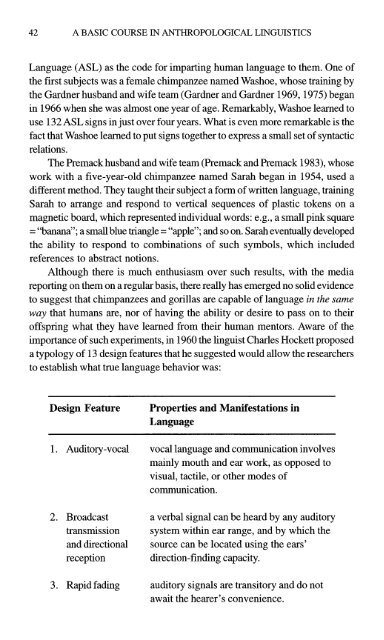A Basic Course in Anthropological Linguistics (Studies in Linguistic ...
A Basic Course in Anthropological Linguistics (Studies in Linguistic ...
A Basic Course in Anthropological Linguistics (Studies in Linguistic ...
You also want an ePaper? Increase the reach of your titles
YUMPU automatically turns print PDFs into web optimized ePapers that Google loves.
42 A BASIC COURSE IN ANTHROPOLOGICAL LINGUISTICS<br />
Language (ASL) as the code for impart<strong>in</strong>g human language to them. One of<br />
the first subjects was a female chimpanzee named Washoe, whose tra<strong>in</strong><strong>in</strong>g by<br />
the Gardner husband and wife team (Gardner and Gardner 1969,1975) began<br />
<strong>in</strong> 1966 when she was almost one year of age. Remarkably, Washoe learned to<br />
use 132 ASL signs <strong>in</strong> just over four years. What is even more remarkable is the<br />
fact that Washoe learned to put signs together to express a small set of syntactic<br />
relations.<br />
The Premack husband and wife team (Premack and Premack 1983), whose<br />
work with a five-year-old chimpanzee named Sarah began <strong>in</strong> 1954, used a<br />
different method. They taught their subject a form of written language, tra<strong>in</strong><strong>in</strong>g<br />
Sarah to arrange and respond to vertical sequences of plastic tokens on a<br />
magnetic board, which represented <strong>in</strong>dividual words: e.g., a small p<strong>in</strong>k square<br />
= “banana”; a small blue triangle = “apple”; and so on. Sarah eventually developed<br />
the ability to respond to comb<strong>in</strong>ations of such symbols, which <strong>in</strong>cluded<br />
references to abstract notions.<br />
Although there is much enthusiasm over such results, with the media<br />
report<strong>in</strong>g on them on a regular basis, there really has emerged no solid evidence<br />
to suggest that chimpanzees and gorillas are capable of language <strong>in</strong> the same<br />
way that humans are, nor of hav<strong>in</strong>g the ability or desire to pass on to their<br />
offspr<strong>in</strong>g what they have learned from their human mentors. Aware of the<br />
importance of such experiments, <strong>in</strong> 1960 the l<strong>in</strong>guist Charles Hockett proposed<br />
a typology of 13 design features that he suggested would allow the researchers<br />
to establish what true language behavior was:<br />
Design Feature Properties and Manifestations <strong>in</strong><br />
Language<br />
1. Auditory-vocal vocal language and communication <strong>in</strong>volves<br />
ma<strong>in</strong>ly mouth and ear work, as opposed to<br />
visual, tactile, or other modes of<br />
communication.<br />
2. Broadcast a verbal signal can be heard by any auditory<br />
transmission system with<strong>in</strong> ear range, and by which the<br />
and directional source can be located us<strong>in</strong>g the ears’<br />
reception direction-f<strong>in</strong>d<strong>in</strong>g capacity.<br />
3. Rapid fad<strong>in</strong>g auditory signals are transitory and do not<br />
await the hearer’s convenience.






